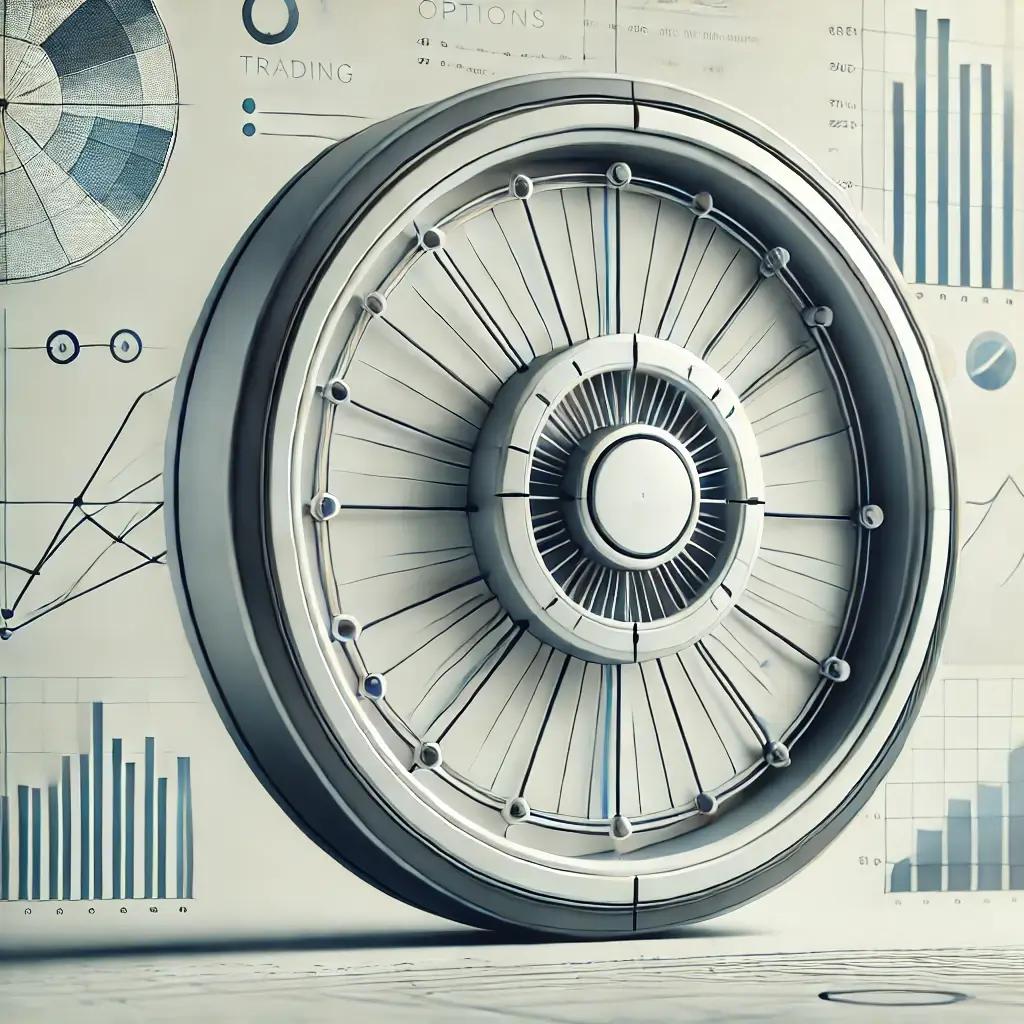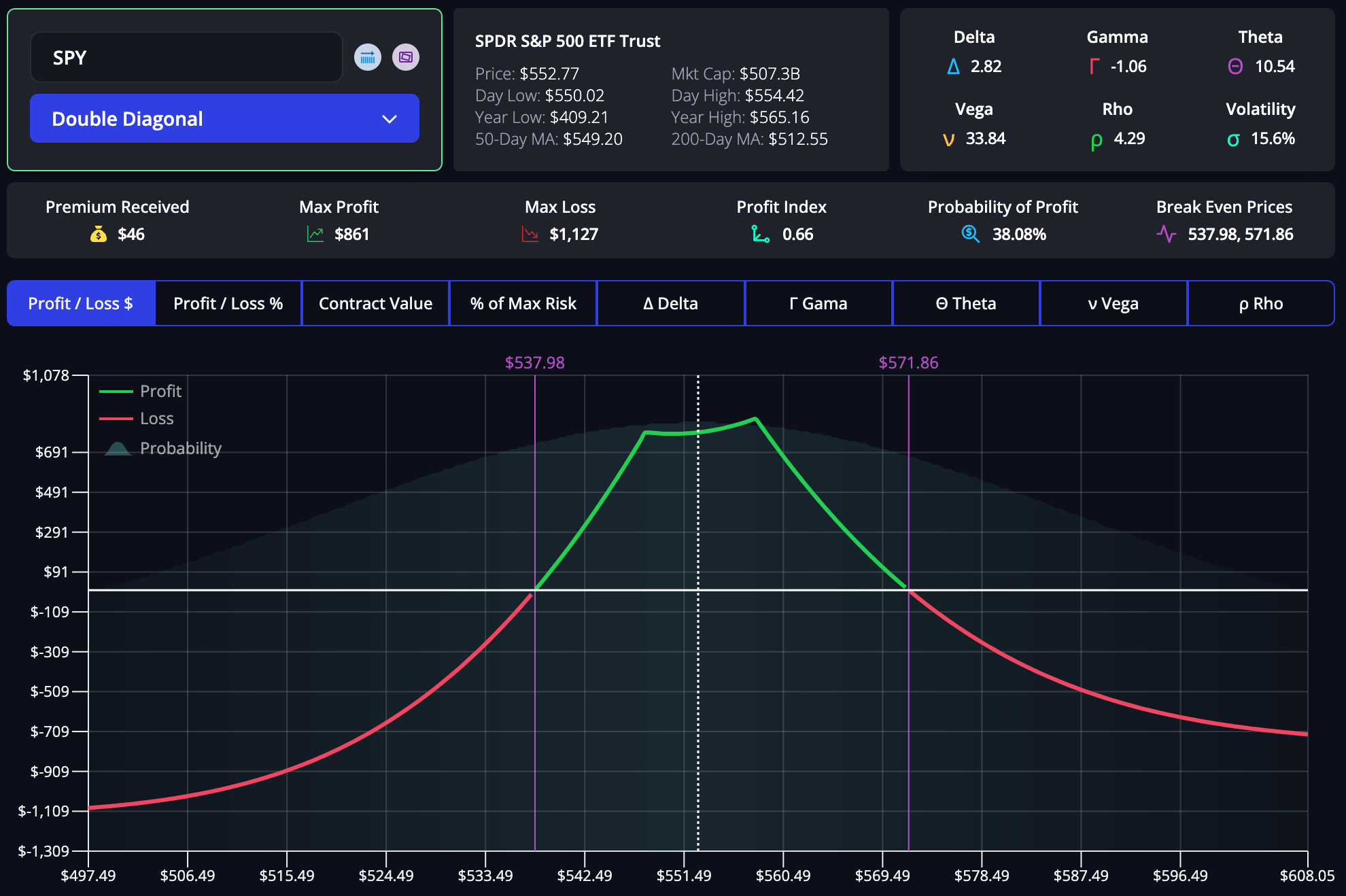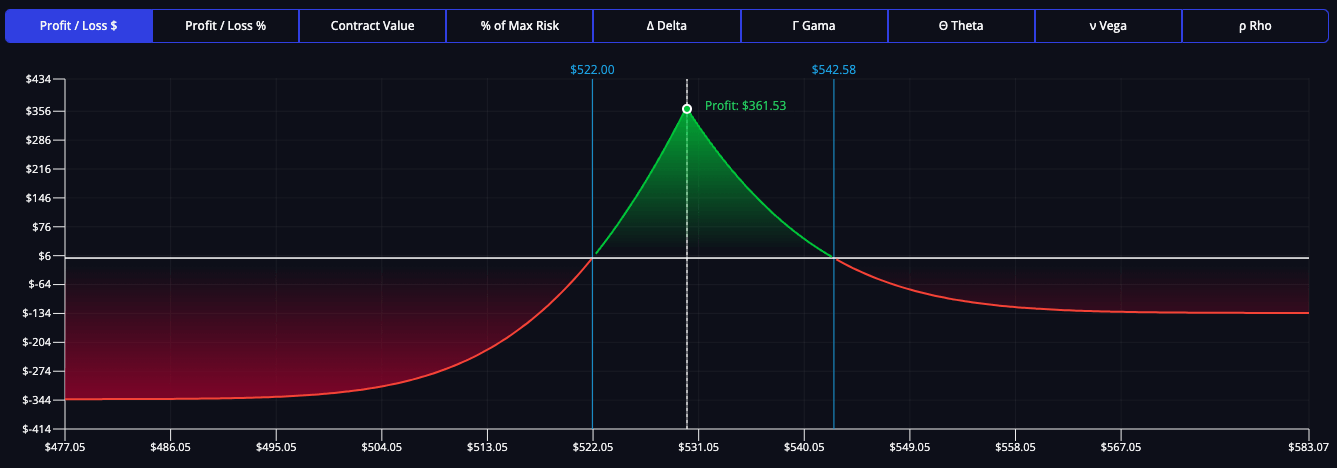Complete Guide to Wheel Options Trading Strategy

What is the Wheel Options Trading Strategy?
Defining the Wheel Options Trading Strategy
The Wheel Options Trading Strategy is a systematic and methodical approach to options trading that combines the selling of puts and calls to generate income while potentially owning the underlying stocks. It's a strategy designed for income-seeking investors who are also comfortable owning the underlying stocks if the options are assigned.
Historically, the Wheel strategy evolved from the basic covered call approach where an investor owns a stock and sells call options against that stock position. What sets the Wheel apart is its initial step of selling puts to potentially acquire stocks at a discount, and only later, if assigned the stock, transitioning into selling calls. This strategy has grown in popularity among retail investors due to its simplicity and the income-generating potential through premiums received from selling options.
Compared to straightforward long call or long put positions, the Wheel strategy offers a more conservative risk profile by generating income through premiums while also providing opportunities to acquire or dispose of stocks methodically. It stands out by integrating both bullish and bearish market sentiments effectively through its rotational use of puts and calls, unlike strategies that purely speculate on one directional market move.
Key Characteristics and Conditions
The Wheel strategy is characterized primarily by its cyclical process of selling puts until assigned the stock, then holding the stock while selling calls until the stock is called away. This cyclic process can repeat indefinitely, hence the name "Wheel."
- Profit Potential: The primary profit in the Wheel strategy comes from the premiums collected from selling puts and calls. Additionally, there could be capital gains if the stock is sold higher than its purchase price.
- Risk Level: The risks include the obligation to buy the stock if the put options are assigned, which could result in holding a depreciating asset in a falling market. However, the risk is somewhat mitigated by the premium income and the potential upside of owning the stock.
- Ideal Market Conditions: This strategy thrives in a market with moderate volatility, where the premium prices are favorable but the market isn’t so volatile as to cause significant losses upon assignment of the stocks. It also suits range-bound markets where the stock price fluctuates within a predictable range, allowing the trader to sell calls and puts repetitively without the risk of large, unexpected price moves.
Key Takeaways:
- The Wheel strategy involves selling puts to acquire stocks and then selling calls to generate income and potentially sell the stocks at a profit.
- It offers a balanced risk profile by providing income through option premiums, with additional profit potential through strategic stock sales.
- Best suited for markets with moderate volatility and predictable price movements, allowing repetitive premium collection and effective stock management.
Steps for Trading Wheel Options Trading Strategy

Preparing for Trade
To engage successfully in the Wheel Options Trading Strategy, traders need a robust preparation framework that begins with choosing an appropriate trading platform. The platform should offer advanced options trading tools, real-time data, and insights into options pricing. Understanding the option chain for each stock is crucial, as it shows available strike prices, expiration dates, and current pricing, all vital for decision-making in the Wheel strategy.
Initial preparation also involves selecting stocks that fit the criteria for the Wheel strategy—typically stocks with relatively stable prices and good liquidity. These stocks should have options that provide sufficient premium to make the strategy worthwhile while not carrying excessive risk. Analyzing past price movements, earnings reports, and other relevant financial news is important to gauge the stability and potential future movements of these stocks.
Selecting the Right Options
Choosing the right options in the Wheel strategy involves several key considerations:
- Strike Price: For put options, select strike prices that you are comfortable potentially buying the stock at, which typically should be at or below the current market value. For call options, choose strike prices at which you are comfortable selling the stock, ideally above the purchase price to ensure a profit if the stock is called away.
- Expiration Dates: Shorter-term options usually offer higher annualized return potential due to their higher theta decay, but they require more frequent management. Longer-term options might provide larger premiums and more cushion against price volatility but tie up capital for longer periods.
Order Placement and Execution
Placing orders in the Wheel strategy must be timed with precision, guided by market analysis and the individual's risk tolerance and strategy goals. The use of limit orders can help control the prices at which options are sold, ensuring that premiums received are within acceptable ranges.
Monitoring the market closely for significant movements that might affect the underlying stocks is crucial. For puts, if a stock price is approaching the strike price, a decision needs to be made whether to allow assignment or roll the option forward. For calls, if the stock price approaches the strike price, traders need to decide whether to let the stock be called away or buy back the option to retain the stock.
Key Takeaways:
- Preparation involves selecting a suitable trading platform and stocks that match the Wheel strategy criteria.
- Choosing the right options requires careful consideration of strike prices and expiration dates to balance profit potential and risk.
- Effective order placement and execution are vital, with timing based on comprehensive market analysis and strategic goals.
HIGH POTENTIAL TRADES SENT DIRECTLY TO YOUR INBOX
Add your email to receive our free daily newsletter. No spam, unsubscribe anytime.
Goal and Financial Objectives of Wheel Options Trading Strategy

Financial Objectives and Strategic Goals
The primary financial goal of the Wheel Options Trading Strategy is to generate steady income through the collection of premiums from selling puts and calls. This strategy is particularly appealing to investors looking for consistent returns rather than speculative gains. It allows for the accumulation of small, regular profits which, over time, can compound significantly.
Strategically, the Wheel aims to create a balanced trading approach that incorporates both the selling of puts for income and the potential ownership of stocks at a lower cost. When these stocks appreciate in value, selling calls against them can further enhance profitability or help manage potential losses. The dual nature of this strategy—earning from options and capitalizing on stock ownership—provides a more dynamic investment approach compared to simple buy-and-hold strategies.
Breakeven Analysis and Profitability
Calculating the breakeven point in the Wheel strategy involves considering the premiums received against any potential decrease in stock value. For instance, if a trader sells a put for a $200 premium with a strike price of $50, the breakeven would effectively be $48 ($50 - $2.00). The stock can decline up to this price before the trade results in a loss.
Profitability in the Wheel strategy is typically measured not just by the premiums collected but also by the overall performance of the stock during the holding period. If the stock price remains stable or increases, and options continue to be written against it, the compounded income from premiums can represent a significant return on investment. However, the strategy can also lead to losses if the underlying stock declines significantly beyond the premiums collected, which necessitates careful stock selection and ongoing management.
Key Takeaways:
- The Wheel strategy aims to achieve consistent income through premiums, with the potential for additional gains through strategic stock sales.
- Breakeven points must be managed by considering premiums against potential stock depreciation.
- Profitability hinges on regular premium collection and favorable stock price movements, requiring diligent stock selection and risk management.
Effect of Time on Wheel Options Trading Strategy

Time Decay and Strategy Performance
Time decay, or theta, plays a critical role in the Wheel Options Trading Strategy, primarily benefiting the trader by eroding the value of options as they approach expiration. This natural decrease in option prices, especially as expiration nears, works in favor of the seller (the strategy’s user) because it increases the likelihood of the options expiring worthless, allowing the trader to retain the full premium.
In the context of the Wheel strategy, traders typically prefer selling options with shorter expiration terms—often 30 to 45 days out. This duration strikes a balance between benefiting from rapid time decay and managing the frequency of trade execution. Shorter expirations mean that premiums are collected more frequently, which can be reinvested sooner, compounding the income potential.
Strategies to Counter Time Decay
While time decay is generally beneficial when selling options, managing its impact is crucial, particularly when the market moves against the position. For example, if a stock price drops significantly and the trader is assigned the stock via put options, the subsequent call options sold to potentially dispose of the stock may have reduced premiums if shorter expirations are chosen.
To mitigate such risks, traders might adjust the expiration lengths based on market conditions and their outlook on the stock. If a recovery in the stock price is anticipated, longer expirations might be chosen for call options to allow more time for the stock to appreciate. Conversely, in a bearish outlook, maintaining shorter expirations for puts might be preferable to limit long-term commitments to falling stocks.
Key Takeaways:
- Time decay is a beneficial aspect of the Wheel strategy, allowing traders to profit from the erosion of option values over time.
- Shorter expiration periods are typically preferred to maximize the impact of time decay, enhancing income through frequent premium collection.
- Strategic adjustments to expiration lengths can help manage risks associated with significant stock price movements, aligning trading tactics with current market conditions.
Volatility and Wheel Options Trading Strategy

Navigating and Capitalizing on Volatility
Volatility is a pivotal factor in the Wheel Options Trading Strategy, influencing both the risk and reward aspects of trading. Volatility measures the rate at which the price of the underlying stock increases or decreases for a given set of returns. High volatility increases the premium of options because of the greater uncertainty and higher risk of significant price movements. This can be advantageous for the Wheel strategy, as higher premiums mean more income from selling options.
Traders using the Wheel strategy need to adeptly navigate periods of high and low volatility. During high volatility, while the premiums collected are higher, there is also a greater risk of the stock moving against the positions (either falling past put strike prices or rising past call strike prices). Effective management involves not only choosing the right strikes and expirations to balance these risks but also deciding whether to enter new positions or wait out volatile periods.
Strategies for Navigating Volatility
- Volatility Analysis: Continuous monitoring of volatility indicators like the VIX, which measures market expectation of near-term volatility conveyed by stock index option prices, helps in making informed decisions. Understanding whether current volatility is higher or lower than historical trends can guide the selection of strike prices and the decision on whether to sell puts or calls.
- Dynamic Strike Selection: In higher volatility, choosing strikes that are further out-of-the-money can provide a cushion against rapid price movements. This approach reduces the likelihood of assignment but still captures high premiums. In lower volatility, strikes can be closer to the current stock price to maximize income potential, given the lower risk of significant price swings.
- Adapting to Market Conditions: During unusually high volatility, it may be prudent to increase the frequency of monitoring and potentially reduce the size of positions to manage risk more effectively. Conversely, in stable times, it might be beneficial to extend the durations or increase the size of positions to maximize income.
Key Takeaways:
- Volatility significantly impacts the premiums of options, which are a critical component of the Wheel strategy’s profitability.
- Traders must continuously analyze market volatility to choose appropriate strike prices and decide on the timing of option sales.
- Adapting strategies to current volatility levels can help manage risks and capitalize on opportunities, maintaining a balance between income generation and risk exposure.
The Greeks: Risk, Theta, Delta, Vega, Gamma, Rho in Wheel Options Trading Strategy

Understanding the "Greeks" is essential for anyone using the Wheel Options Trading Strategy, as they provide deep insights into the risk factors and potential changes in option prices based on various market forces.
Delta
Delta measures the rate at which the price of an option changes with a change in the underlying asset's price. In the context of the Wheel strategy, where both puts and calls are sold, managing delta is crucial to ensuring that the options remain out of the money. For puts, a negative delta (indicating the option price moves inversely to the stock price) helps in risk management, while for calls, a positive delta (option price moves in tandem with the stock price) can increase the risk of the option being called away.
Gamma
Gamma reflects the rate of change in delta over time and is important for understanding how quickly the risks associated with delta might change. A high gamma requires more frequent adjustments to the portfolio to manage risks effectively, especially as the expiration date approaches and the stock price nears the strike price of the sold options in the Wheel strategy.
Theta
Theta represents time decay, which is the reduction in the value of options as they approach expiration. This is inherently beneficial in the Wheel strategy since selling options means the trader profits from the acceleration in time decay, particularly when options are close to their expiration.
Vega
Vega measures the sensitivity of an option's price to changes in the volatility of the underlying asset. Since higher volatility can increase the premiums received from selling options, a high vega can be advantageous in the Wheel strategy. However, it also increases the risk if the market becomes too volatile, potentially leading to rapid adverse price movements.
Rho
Rho is less significant in the context of the Wheel strategy but still worth monitoring. It measures the sensitivity of an option's price to changes in interest rates. Given that changes in rates can affect stock prices and the overall market, understanding rho can provide additional insights, especially for long-term options if interest rates are expected to change.
Real-world Examples Illustrating the Greeks' Impact
For instance, suppose a trader has sold put options with a high negative delta in a rising market. The rising market decreases the likelihood of the stock hitting the strike price, making it beneficial as the trader can keep the premium without assignment. Conversely, if the trader has sold calls with a high positive delta, and the stock price increases rapidly, there's a high risk of these options being exercised, potentially leading to the stock being called away.
Managing these Greeks effectively involves continuous monitoring and adjusting of positions to align with the current market conditions and the trader’s risk tolerance and strategy objectives.
Key Takeaways:
- Each Greek (Delta, Gamma, Theta, Vega, Rho) plays a crucial role in understanding and managing the risks and rewards in the Wheel Options Trading Strategy.
- Theta and Vega are particularly beneficial for this strategy, enhancing profitability through time decay and volatility.
- Effective management of Delta and Gamma is necessary to prevent substantial losses and optimize the strategy’s effectiveness.
Pros and Cons of Wheel Options Trading Strategy

Advantages of the Strategy
The Wheel Options Trading Strategy offers several benefits that make it attractive for a wide range of investors, particularly those looking for consistent income and the potential for stock ownership at discounted prices.
- Income Generation: One of the most compelling advantages of the Wheel strategy is its ability to generate steady income through the collection of premiums from the options sold. This feature appeals to investors who prefer regular earnings over potentially higher but less predictable capital gains.
- Lower Volatility Exposure: Compared to other trading strategies that might expose investors to significant market volatility, the Wheel strategy helps mitigate these risks through its systematic selling of options, which provides income even in fluctuating markets.
- Potential for Stock Acquisition Below Market Value: By selling put options, investors have the potential to acquire stocks at a price below the current market value if the options are assigned. This can lead to excellent buying opportunities in a well-managed portfolio.
- Flexibility in Asset Management: The strategy provides flexibility in managing the assets. If the stock is assigned via puts, the trader can then sell calls against it, potentially increasing the overall returns or efficiently managing the holdings based on market conditions.
Risks and Limitations
While the Wheel strategy has its advantages, it also comes with specific risks and limitations that traders must consider.
- Risk of Stock Depreciation: If the put options are assigned, the trader must purchase the stock at the strike price, which could be higher than the current market value if the stock’s price has fallen significantly. This situation can lead to losses if the price continues to drop and calls cannot be sold at profitable strike prices.
- Capital Intensive: The strategy requires a significant amount of capital to hold the underlying stocks when puts are assigned. This can tie up funds that might otherwise be used for different investments.
- Management Intensity: The Wheel strategy requires ongoing management and monitoring of positions, particularly to adjust for market movements and manage risks related to the Greeks. It can be time-consuming and requires a solid understanding of options trading.
- Opportunity Costs: There are potential opportunity costs involved with the Wheel strategy. The capital used to purchase stocks if puts are assigned might be locked in for longer than anticipated, especially if the stock price stagnates or falls, reducing the flexibility to invest in other, potentially more profitable opportunities.
Key Takeaways:
- The Wheel strategy is beneficial for regular income generation and provides opportunities to purchase stocks below market value.
- It offers a lower exposure to market volatility while providing flexibility in managing assets.
- However, risks include potential significant stock depreciation, high capital requirements, intensive management needs, and possible opportunity costs.
Tips for Trading Wheel Options Trading Strategy

Practical Insights and Best Practices
To maximize success with the Wheel Options Trading Strategy, traders should adhere to several best practices that can enhance decision-making and risk management.
- Selection of Underlying Stocks: Choose stocks that are fundamentally sound, with good liquidity and less prone to extreme volatility. This selection reduces the risk of substantial losses if the stock needs to be held due to option assignments.
- Premium Optimization: Focus on selling options with premiums that provide a good balance between risk and reward. Higher premiums might be tempting but often come with greater risk of the stock moving against the position.
- Regular Monitoring and Adjustments: Continuously monitor the market and adjust the strategy as needed. This includes rolling out options to different strike prices or expiration dates to manage risk or capture better premiums.
- Diversification: While the Wheel strategy can be profitable, it should not constitute the entire investment portfolio. Diversifying across different assets and strategies can mitigate potential losses and provide more stable overall investment returns.
- Use of Technology: Leverage technology platforms that provide real-time data, analytical tools, and automatic alerts for price movements and other market changes. These tools can significantly aid in making informed decisions quickly.
Avoiding Common Mistakes
In addition to following best practices, avoiding common pitfalls is crucial for those employing the Wheel strategy.
- Avoid Emotional Trading: Stick to the predefined strategy rules and avoid making decisions based on emotions. Emotional trading can lead to poor decisions, such as holding onto stocks for too long or selling options at non-optimal times.
- Ignoring Market Trends: Be aware of broader market trends and economic indicators that can impact stock prices. Ignoring these can result in unexpected losses if the market moves significantly against the trader’s positions.
- Overexposure to a Single Stock: Avoid having too much capital tied up in a single stock or a small group of stocks. This overexposure can increase risk if those stocks perform poorly.
- Neglecting Exit Strategies: Always have clear exit strategies for both entering and exiting positions. Know when and under what circumstances the position will be closed, either at a profit or a loss.
Key Takeaways:
- Implementing the Wheel strategy effectively requires careful stock selection, optimization of premiums, and regular strategy adjustments.
- Best practices also include leveraging technology for better market monitoring and maintaining a diversified portfolio.
- Common pitfalls to avoid include emotional trading, ignoring broader market trends, overexposure to single stocks, and neglecting to plan exit strategies.
The Math Behind Wheel Options Trading Strategy

Formulae and Calculations Explained
Understanding the mathematics involved in the Wheel Options Trading Strategy is crucial for effective implementation and risk management. The key components to focus on include the calculation of premiums, potential profits, losses, and the adjustment of strike prices and expiration dates based on market dynamics.
Option Premium Calculation:
The premium received from selling an option is influenced by several factors, including the volatility of the underlying stock, the time until expiration, and the distance of the strike price from the current stock price. The Black-Scholes formula, for instance, is commonly used to estimate the fair value of options and can be helpful in setting reasonable expectations for the premiums that can be earned.
Profit and Loss Calculations:
- Profit: When options expire worthless, the full premium collected is the profit. If a stock is assigned via puts and later sold via calls at a higher strike price, the profit includes both the premium collected and any capital gains from the stock sale.
- Loss: If a put is assigned and the stock's price falls below the strike price, the loss is the difference between the stock purchase price (strike price) and the current lower market price, minus the premium received.
Breakeven Analysis:
- For puts, the breakeven point is the strike price minus the premium received. For instance, if you sell a put with a $50 strike price and receive a $2 premium, your breakeven on the stock acquisition is $48. If assigned the stock, selling calls consistently collects additional premiums that reduce the overall cost basis further.
Calculating Option Value and Breakeven
To illustrate, consider the following scenarios:
- A put option is sold with a strike price of $100, and a premium of $5 is received. If the stock price stays above $100, the trader keeps the $5 premium. If the stock falls to $95 and the option is assigned, the trader buys the stock at $100 but effectively pays $95 after the premium, breaking even.
- If the trader is assigned the stock and sells a call with a strike price of $105 and receives a $3 premium, the new breakeven would be $92 ($100 - $5 - $3), assuming no change in stock price at call sale time. If the stock price rises and the shares are called away at $105, the profit is $13 per share ($105 - $92).
Key Takeaways:
- Effective use of the Wheel strategy involves precise calculations of option premiums, profits, and losses to manage financial outcomes proactively.
- Breakeven points and adjustments in option sales are critical for maintaining profitability and managing the ongoing cost basis of stock holdings.
- Regular reassessment and recalibration of the strategy based on mathematical outcomes and market conditions are necessary to optimize returns and minimize risks.
Case Study: Implementing Wheel Options Trading Strategy

Real-World Application and Analysis
Let’s examine a practical application of the Wheel Options Trading Strategy with a case study involving a fictional company, XYZ Corp. Suppose XYZ Corp is a well-established company with stable earnings and moderate stock price volatility, making it a suitable candidate for this strategy.
- Initial Setup: A trader begins by selling put options for XYZ Corp with a strike price of $50 and collects a premium of $3 per option. The market price for XYZ at the time is $52.
- Market Movement: Over the next month, XYZ’s stock price drops to $49 due to a mild market downturn. The put options are assigned, and the trader acquires the stock at $50 per share, effectively paying $47 per share after accounting for the premium received.
- Continued Strategy: The trader then begins to sell call options with a strike price of $55, collecting an additional premium of $2.50 per option. The objective is to either earn more through premiums or sell the stock at a profit if the calls are exercised.
- Resolution: Two months later, XYZ’s stock price rebounds to $56 following positive industry news. The call options are exercised, and the stock is sold at $55. The trader makes a profit on the sale price over the effective stock purchase price and collects premiums from both the puts and calls.
Analysis of the Case Study with Unique Insights and Lessons
- Market Research and Selection: Choosing XYZ Corp based on its stable history and moderate volatility was crucial. This selection minimized the risk of significant price drops and maximized the effectiveness of the Wheel strategy.
- Premium Management: Collecting premiums at each step provided a buffer against potential losses and improved overall profitability. This illustrates how crucial option pricing and timing are to the strategy’s success.
- Risk and Reward Balance: While the trader was exposed to risk when the stock price initially dropped, the premiums collected and the eventual increase in stock price mitigated those risks and led to a profitable outcome.
- Flexibility and Adjustment: The trader’s readiness to adjust strike prices and hold onto the stock during a downturn demonstrates the importance of flexibility in options trading. Decisive actions based on market movements were key to maximizing returns.
Key Takeaways:
- Successful implementation of the Wheel strategy requires careful selection of stable stocks and strategic premium management.
- Risks associated with potential stock devaluation can be mitigated through collected premiums and strategic adjustments in option sales.
- Flexibility in managing trades, coupled with a solid understanding of market conditions, can lead to significant profitability, exemplifying the strategy’s potential for regular income and capital gains.
Maximizing the Wheel Strategy with InsiderFinance Options Profit Calculator

Using the InsiderFinance Options Profit Calculator can significantly enhance your Wheel Options Trading Strategy. This advanced tool offers several compelling benefits:
- Superior User Experience: The intuitive interface makes navigating complex calculations seamless, allowing both novice and experienced traders to optimize their strategies efficiently.
- Enhanced Accuracy: Get the most precise insights, ensuring you maximize premiums and manage risks effectively.
- Detailed Analysis: Effortlessly analyze potential trades, forecast profit and loss scenarios, and make informed decisions with confidence.
- Real-Time Data: Access up-to-date market information and insights to stay ahead in your trading strategies.
Ready to elevate your Wheel Options Trading Strategy? Try the InsiderFinance Options Profit Calculator today and experience the difference in your trading outcomes.
HIGH POTENTIAL TRADES SENT DIRECTLY TO YOUR INBOX
Add your email to receive our free daily newsletter. No spam, unsubscribe anytime.
FAQs
What is the Wheel Options Trading Strategy?
The Wheel Options Trading Strategy is a systematic approach to options trading that involves selling put options to potentially buy stocks at a discount, then selling call options on the stocks owned. This strategy is designed to generate regular income from option premiums and potentially profit from stock ownership.
How do I select stocks for the Wheel strategy?
Select stocks that are fundamentally strong, have good liquidity, and exhibit less extreme volatility. It’s advisable to choose stocks that you would be comfortable holding long-term, as the strategy may require holding the stocks for extended periods if the market turns unfavorable.
What are the risks involved in the Wheel strategy?
The primary risks include the potential for stock prices to fall significantly after put options are assigned, leading to losses that exceed the collected premiums. Additionally, there is the risk of opportunity cost, where capital is tied up in stocks that may perform poorly or stagnate.
How important is option selection in the Wheel strategy?
Very important. Option selection—choosing the right strike prices and expiration dates—is crucial for balancing risk and return. It affects the premium income, the likelihood of assignment, and the overall profitability of the strategy
Can the Wheel strategy be used in all market conditions?
The Wheel strategy is versatile but performs best in markets with moderate volatility. High volatility can increase premiums but also the risk of significant price movements leading to assignments at unfavorable prices. In very low volatility, premiums may be too low to provide worthwhile returns.
How does time decay (theta) affect the Wheel strategy?
Time decay benefits the Wheel strategy, as the value of options sold (both puts and calls) decreases over time. This decay allows the seller to potentially buy back options at a lower price or let them expire worthless, retaining the full premium.
What role does implied volatility play in the Wheel strategy?
Implied volatility impacts the premium received for options sold. Higher implied volatility increases premiums, enhancing potential income but also indicating higher risk of price swings that could lead to option assignments.
How can adjustments be made during the cycle of the Wheel strategy?
Adjustments may include rolling out options to later dates or different strike prices to avoid assignment or to capture higher premiums. Monitoring market conditions and adjusting the strategy accordingly is key to managing risks and maximizing returns.
Is the Wheel strategy suitable for beginner traders?
The Wheel strategy can be suitable for beginners who have a basic understanding of options trading. However, it requires a commitment to learning about market analysis, option valuation, and risk management. Beginners should start with small positions and increase exposure as they gain experience and confidence.








